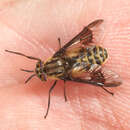Conservation Status
provided by University of Alberta Museums
Chrysops furcatus is common and widespread; in Labrador and Quebec, it was the second mostly commonly captured deerfly (McElligott and Lewis, 1998).
- license
- cc-by-nc
- copyright
- University of Alberta Museums
Cyclicity
provided by University of Alberta Museums
Specimens have been collected from late June to early August.
- license
- cc-by-nc
- copyright
- University of Alberta Museums
Distribution
provided by University of Alberta Museums
Throughout Canada and Alaska, south to California and Wisconsin (Stone et al., 1965).
- license
- cc-by-nc
- copyright
- University of Alberta Museums
General Description
provided by University of Alberta Museums
"Adults (Teskey 1990): Females are 7-10 mm in length, and are patterned orange and black overall. On the head, the frons is slightly higher than wide; the ocellar prominence with extensive glossy black area; the antenna black except for the the orangish scape (or even a few segments higher on the antenna); clypeus entirely yellow; palpi brown. The thorax is covered with yellow hairs and is distinctly striped with grey and black; the front coxa and mid and hind tibia, femora, and basitarsi are blackened, remainder yellowish; on the wings, the apex of the basal radial cell is clear while the basal portion and the basal median cell are infuscated (pigmented). On the abdomen, the black spot on tergum 1 is joined to the geminate (doubled) spot on tergum 2 which encloses a median yellow triangle; tergites 3-7 are black anteriorly with yellow posterior margins.
The males are similar to the females, except they are smaller, the scutum is nearly black, there are medial black figures on tergites 1-2, and abdominal segment 1 does not constrict at all when it joins to the thorax.
Chrysops furcatus is superficially similar to C. coloradensis, C. montanus, and C. lateralis, none of which are found in Alberta. However, it can be separated morphologically from those three by wing venation: C. furcatus lacks of infuscation in the apex of the basal radial cell, and the hyaline triangle crosses multiple radial cells (Teskey 1990).
Larvae (Teskey 1969): creamy-white, 15-17 mm in length. It is separated from other Chrysops spp. by the presence of a posterior pubescent annulus extending from the anal segment, making up 1/3 of the length of the segment, and by the length of the respiratory siphon being twice the diameter at the base."
- license
- cc-by-nc
- copyright
- University of Alberta Museums
Habitat
provided by University of Alberta Museums
Specimens have been collected in wetlands with a saturated substrate and high levels of organic matter; probably not a highly habitat-specific species (Teskey 1990).
- license
- cc-by-nc
- copyright
- University of Alberta Museums
Life Cycle
provided by University of Alberta Museums
Not much is known about C. furcatus specifically. Teskey (1990) record that Chrysops in general, however, are known to begin life as an egg mass laid near water or wet soil; the larvae hatch simultaneously and pass through 5-7 instars over 9-10 months (or several years, in the far north) before pupating and emerging as adults in the early summer. Males wait for females at high points and flyways; the females must take a blood meal in order to at least maximize their egg production.
- license
- cc-by-nc
- copyright
- University of Alberta Museums
Trophic Strategy
provided by University of Alberta Museums
Nothing is known of the dietary habits of the larvae, nor of the adults specifically. Adult Chrysops are known to ingest flower nectar and aphid honeydew as their primary food source (Teskey 1990).
- license
- cc-by-nc
- copyright
- University of Alberta Museums
Chrysops furcatus
provided by wikipedia EN
Chrysops furcatus is a species of deer fly in the family Tabanidae.[4][5]
Distribution
Canada, United States.
References
-
^ Walker, F. (1848). List of the specimens of dipterous insects in the collection of the British Museum. part 1. London: British Museum. pp. 1–229.
-
^ Philip, C.B. (1955). "New North American Tabanidae. IX. Notes on and keys to the genus Chrysops Meigen". Revista Brasileira de Entomologia. 3: 47–128.
-
^ Whitney, C.P. (1904). "Descriptions of some new species of Tabanidae". The Canadian Entomologist. 36: 205–207. Retrieved 12 September 2022.
-
^ Moucha, J. (1976). "Horse-flies (Diptera: Tabanidae) of the World. Synoptic Catalogue" (PDF). Acta Entomologica Musei Nationalis Pragae Supplements. 7: 1–320. Retrieved 11 September 2022.
-
^ Burger, J. F. (1995). "Catalog of Tabanidae (Diptera) in North America north of Mexico". International Contributions on Entomology. Associated Publishers. 1 (1): 1–100.

- license
- cc-by-sa-3.0
- copyright
- Wikipedia authors and editors
Chrysops furcatus: Brief Summary
provided by wikipedia EN
Chrysops furcatus is a species of deer fly in the family Tabanidae.
- license
- cc-by-sa-3.0
- copyright
- Wikipedia authors and editors

